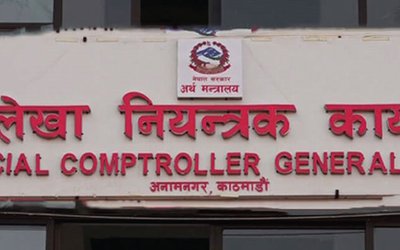Nepal seems to be making some economic progress. According to a recently released report of the International Monetary Fund (IMF), the economy is rebounding, thanks to the government efforts, after a slowdown caused by the 2015 earthquakes and subsequent trade disruptions.
Even as Nepal’s economic growth was below one percent last fiscal year, IMF expects the growth will reach 5.5 percent in FY 2016/17. The figure is higher than the growth rate of the last few years.
In view of Nepal’s current political instability, economists suggest stronger policies on the economic front.
“Strong policies are needed to enhance the confidence amid the ongoing political uncertainty, and to meet the authorities' long-term goal of becoming a middle-income country by 2030,” notes the IMF report.
Led by Geert Almekinders, an International Monetary Fund (IMF) team visited Nepal from January 11-23 and held discussions for the 2017 Article IV consultation.
During the visit, the team met Deputy Prime Minister and Minister of Finance Krishna Bahadur Mahara, Central Bank Governor Chiranjibi Nepal, and other high-level government officials. The team also met with representatives of the private sector, labor unions, and the donor community.
With the good flow of remittances and reconstruction work taking speed, Nepal government’s recent assessment indicated that Nepal’s economic growth will be around six percent.
“Nepal’s economy is rebounding following a slowdown caused by the 2015 earthquakes and trade disruptions, supported by the government’s efforts to revitalize the reform agenda. The key challenge now is to put policies in place that will extend the cyclical recovery into a sustained period of high and inclusive growth," said Almekinders after the conclusion of the visit.
“The mission expects growth to reach 5.5 percent in FY 2016/17 (ending July 15). The normalization of economic activity is being supported by a good monsoon, accommodative monetary policy, and rising government spending. India’s sudden withdrawal of high-denomination banknotes is expected to have a limited impact on activity overall; bank holdings of Indian rupee currency are small but some corporate and households who hold such notes have seen their purchasing power affected. The main risk to the outlook pertains to failure of capital budget implementation to improve.
“The normalization of prices in the aftermath of last year’s trade disruption is pushing down inflation which is expected to undershoot the authorities’ mid-2017 inflation target of 7.5 percent.
“Nepal’s external position remains strong. International reserves of the Nepal Rastra Bank reached a record high of US$8.7 billion in December 2016, equivalent to about 10 months of prospective imports and goods and services. However, following large surpluses in recent years, the external current account is now broadly in balance. This reflects recovering imports and moderating growth of remittances.
“The medium-term outlook critically depends on efforts to sustain and deepen reform momentum. Strong policies are needed to enhance confidence amid ongoing political uncertainty. They are also needed to strengthen key institutions and administrative capacity, which are critical for overcoming the chronic under-implementation of the budget and boosting private investment and growth. Accordingly, in the absence of strong policies, growth would likely revert to the average of the past decade and fall short of substantially improving living standards and social indicators.
“Against this background, the discussions focused on the policies needed to create conditions for sustained high and inclusive growth in line with the authorities’ long-term goal of becoming a middle-income country by 2030, while safeguarding macroeconomic and financial sector stability.
“The team welcomes the authorities’ plans and efforts to scale up government spending to rebuild after the earthquakes and address infrastructure gaps. In view of the still limited implementation capacity, it will be essential to have a realistic budget that effectively prioritizes spending with the largest growth dividends, including in social spending areas of highest importance to inclusive growth. In scaling up public spending, care should also be taken not to exceed the economy’s aggregate absorptive capacity.
“The mission welcomes the central bank’s adoption of an interest rate corridor. Maintaining competitiveness and external balance will require closing the inflation wedge with India on a sustained basis—through a tightening of monetary policy, facilitated by a strengthening of the monetary policy framework.
“Efforts are also needed to narrow the gap in productivity growth with India and other trading partners and to improve the business environment. This requires structural reforms to deregulate product and factor markets, and high-quality investments, including improving electricity supply and expanding transportation infrastructure. Strong policies and reform implementation would boost growth well beyond levels seen in the recent past.
“To mitigate macro-financial risks and increase access to finance, financial sector supervision should be further strengthened and financial sector reforms accelerated, building on the recent progress in strengthening several aspects of the regulatory framework. This would include enhancing loan classification and provisioning and upgrading banks’ risk management. The ceiling on the loan to deposit ratio should be maintained as this will contribute to a welcome moderation of credit growth and normalization of interest rates.”
- TANAHU HYDROPOWER PROEJCT: A Significant Achievement
- Apr 15, 2024
- AMBASSADOR HANAN GODAR: Sharing Pain With A Nepali Family
- Mar 30, 2024
- VISIT OF KfW AND EIB TO NEPAL : Mission Matters
- Mar 25, 2024
- NEPAL BRITAIN SOCIETY: Pratima Pande's Leadership
- Mar 24, 2024
- NEPAL ARMY DAY: Time To Recall Glory
- Mar 15, 2024
















